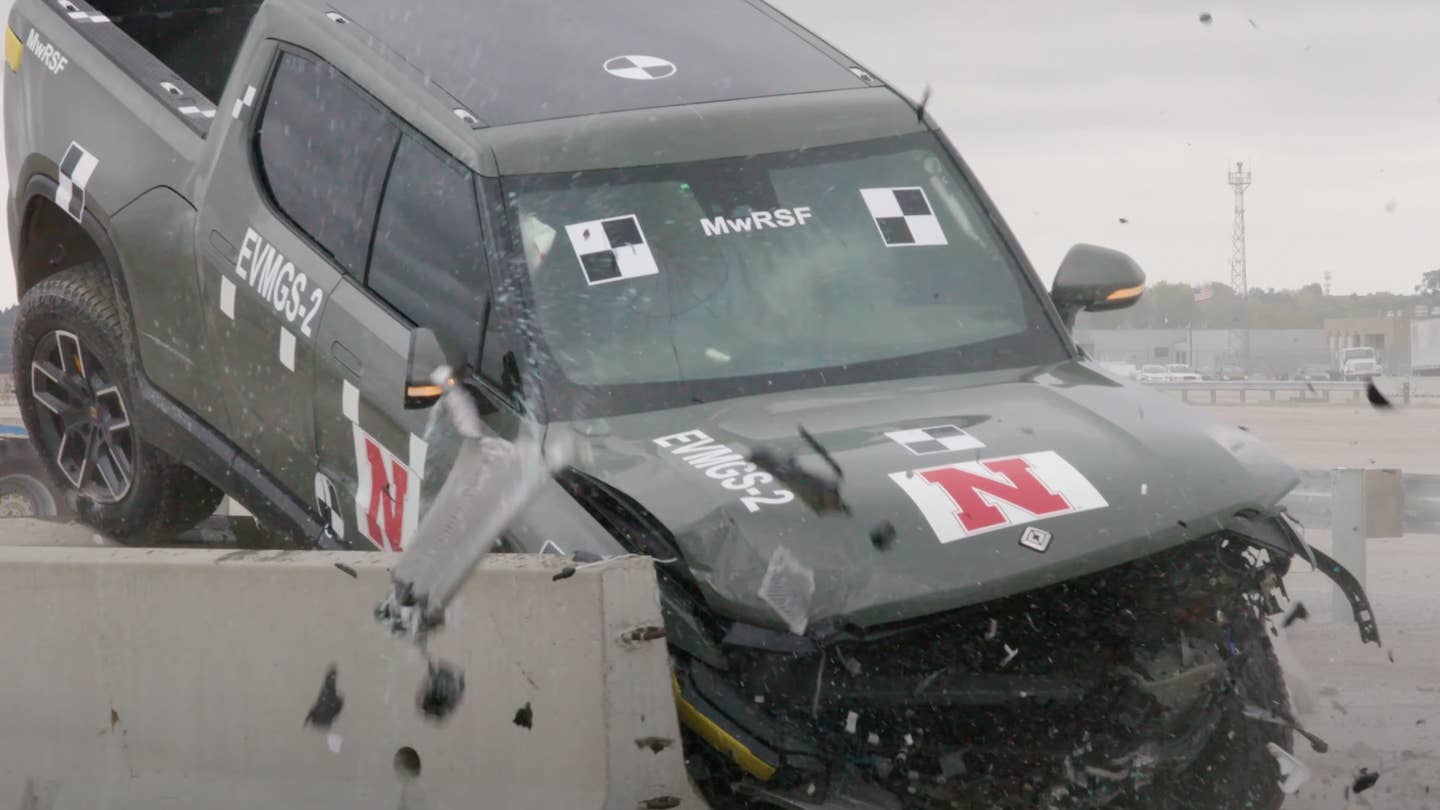Our guardrail system was only built to handle vehicles up to 5,000 pounds.

In the 1990s, the Midwest Roadside Safety Facility looked into the then-50-year-old highway guardrail system and found it to be incapable of handling the increasing number of SUVs and pickups at the time. Guardrails were then redesigned to handle the larger, heavier vehicles that were becoming more and more popular. But that was 30 years ago, long before the recent onslaught of shockingly heavy electric vehicles. What happens when a 7,100-pound Rivian R1T hits a 30-year-old guardrail design? It tears through it like tissue paper, which you can see in this new video from the Midwest Roadside Safety Facility at the University of Nebraska.
According to the Associated Press, both the University of Nebraska and Army Corps of Engineers collaborated to crash a Rivian R1T into a guardrail at 60 mph for research purposes. The 7,100-pound truck obliterates the guardrail and vaults over the concrete median that followed. Although the test initially appears to show an head-on impact, which could be considered unlikely and unrealistic, footage later in the video clarifies that the pickup meets the guardrail at an oblique angle. The barrier used in the test was 31 inches high, made from 12-gauge corrugated steel, mounted on six-inch-deep steel posts.
It isn’t only Rivians, either. “The system was not made to handle vehicles greater than 5,000 pounds,” Cory Stolle, from the university’s Midwest Roadside Safety Facility, told the AP. Many EVs exceed that 5,000-pound weight limit, or are much heavier. The Army Corps of Engineers also crash-tested a Tesla into the guardrail and, rather than going through it, it went underneath and continued.
University of Nebraska via YouTube
Many electric vehicle manufacturers tout the increased safety of EVs, thanks to their unique packaging without engines and transmissions getting in the way. However, that safety is internal. Researchers noted that the passenger compartment of the R1T in question was fine after the test, and its occupants would likely have walked away from the crash without serious injury. However, those passengers wouldn’t be as lucky if their electric pickup ripped through a guardrail at the edge of a cliff, and it goes without saying that anyone in another, lighter vehicle colliding with the Rivian would be at serious risk, too.
“So far, we don’t see good vehicle-to-guardrail compatibility with electric vehicles,” said Stolle.
It’s worth noting that EVs aren’t the only vehicles that crest the 5,000-pound mark. Any full-sized, heavy-duty pickup on the market will easily surpass 6,000 pounds, with some like the Ford F-350 and Silverado HD 2500 even exceeding 7,000 pounds. Even the Chevy Suburban, a fairly common vehicle for families, can tip the scales at over 6,000 pounds depending on its powertrain. But EVs are universally heavier than gas cars of equal dimensions thanks to their batteries, and many of them are already beyond the limit.
Thankfully, guardrails changed before to adapt to rising vehicle weights, and they can change again. While Stolle isn’t certain what types of materials or construction will be needed, suggesting the potential need for more concrete barriers, this is a problem the country has solved before. “We need to know as much as we can now because it takes time to design new systems, evaluate them, and confirm those results with full-scale crash testing,” Stolle told Nebraska Today.
In the meantime, though, owners of EVs and heavy trucks need to know that guardrails won’t always keep them on the road in the event of a crash. If it were me, I wouldn’t do much canyon mobbing in a Rivian R1T or Tesla Cybertruck anytime soon.
Got tips? Send ’em to tips@thedrive.com



